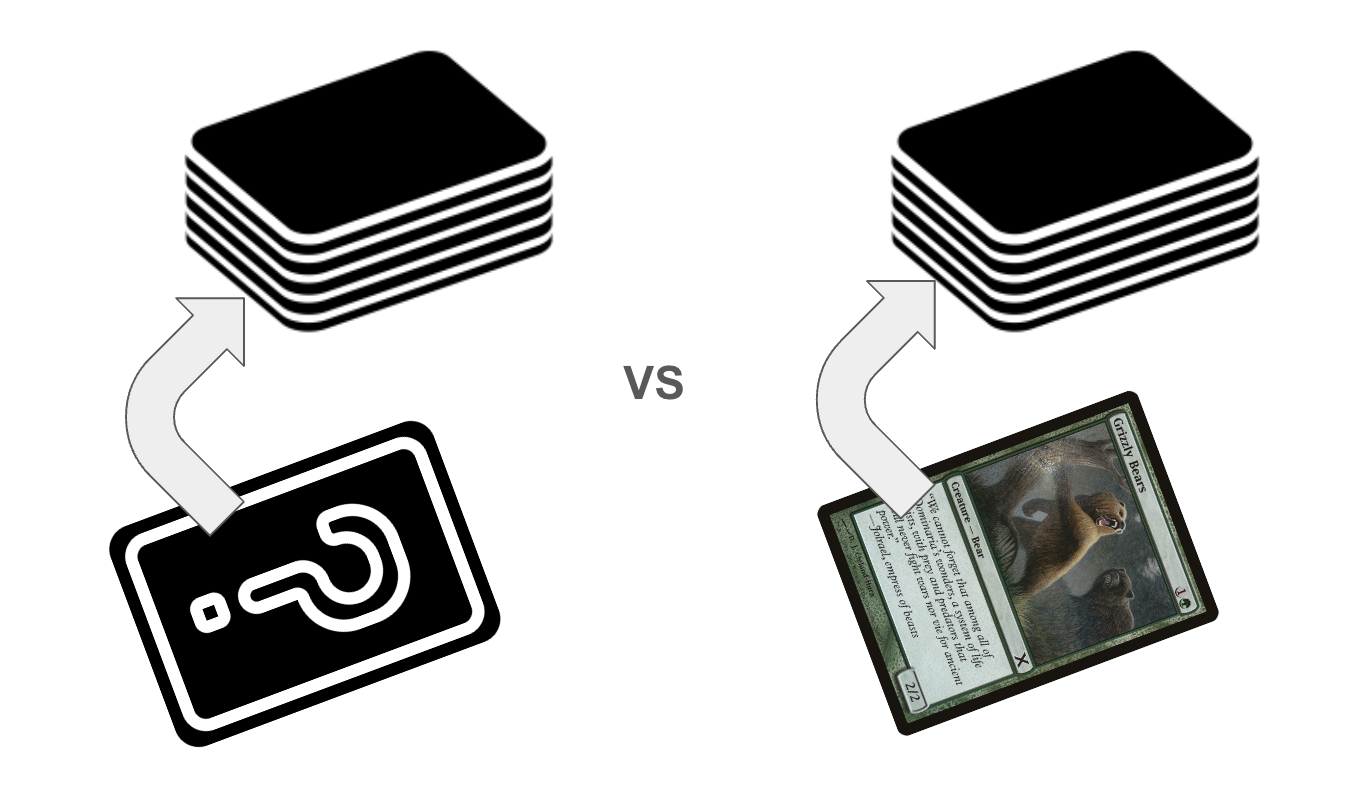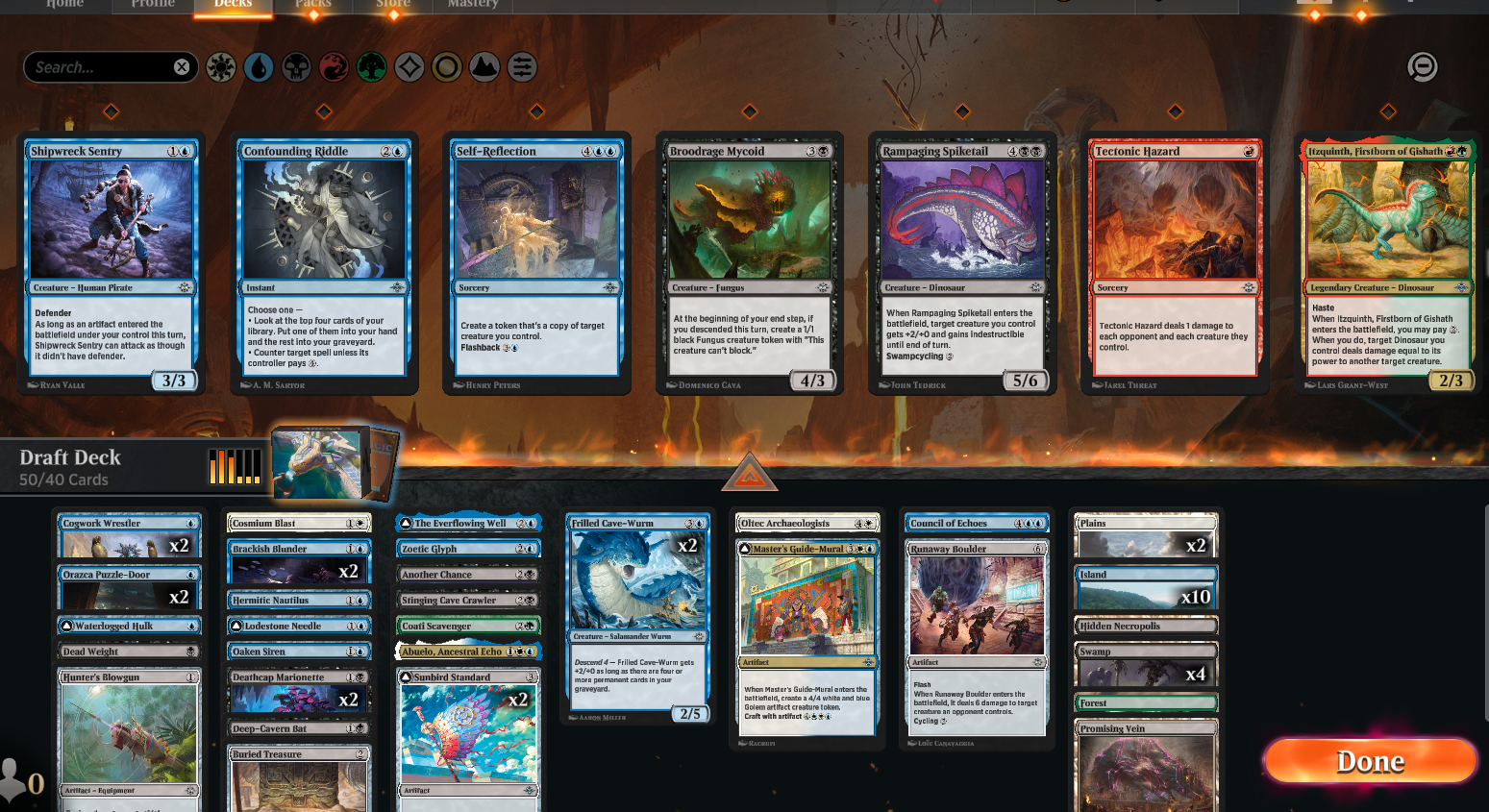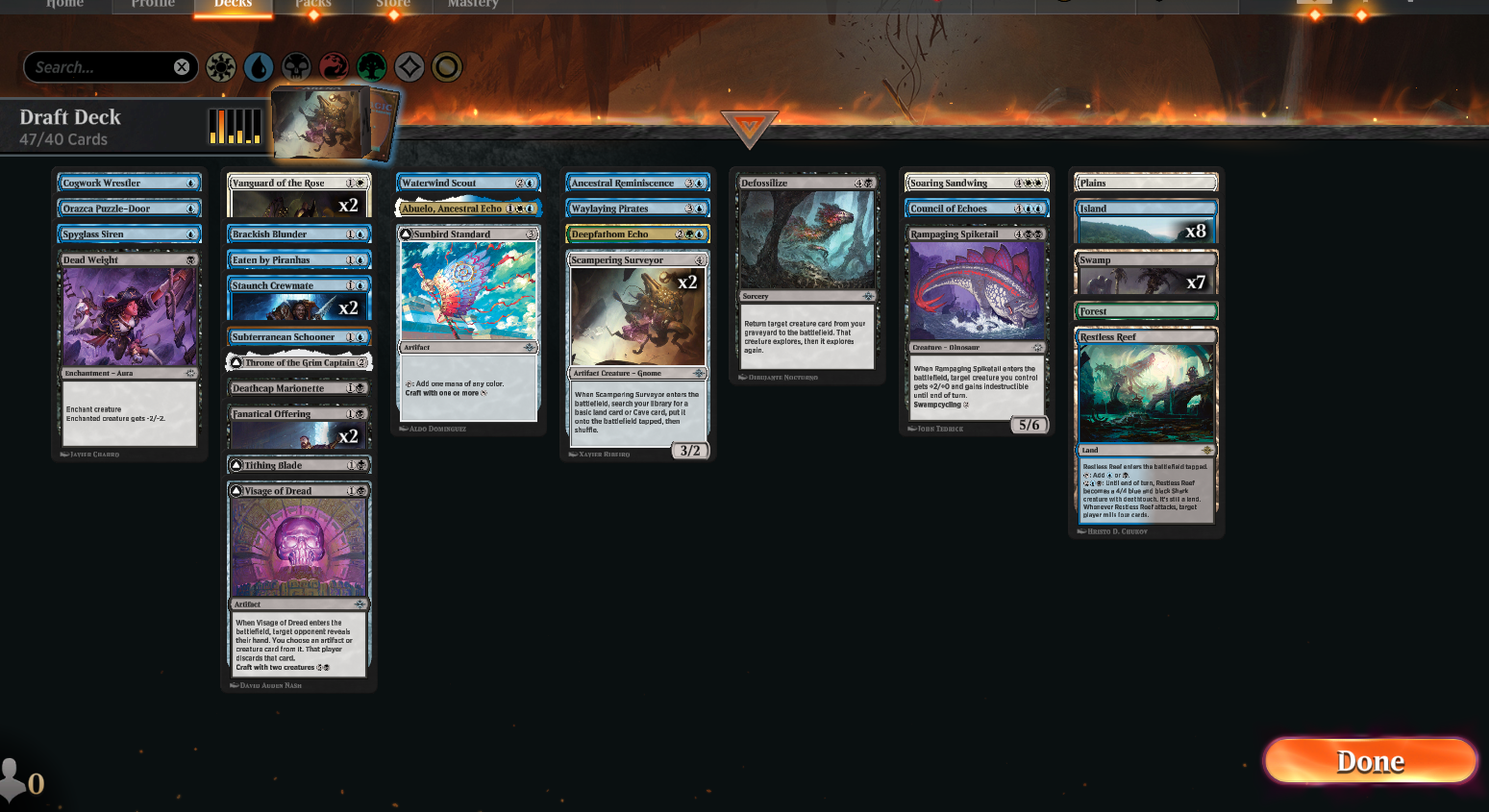More Than 40: When and How to Do It
11/10/2023
One of the hardest parts of limited is making cuts. With recent limited design, you often end up with quite a lot of playable cards at the end of a draft, and deciding which cards fit in slots 20-23 and which cards to leave out in slots 24-26 can be excruciating.
So, naturally, it can be quite tempting to tweak the numbers a bit. Is it so bad to play that 24th spell, going up to 41 cards total? Maybe you convince yourself that it's actually very purposeful, and you've figured out the perfect ratio of threats to interaction or lands to spells that 40 cards just can't meet.
Unfortunately, it's quite easy to trick yourself this way; the simple answer is that you should almost never play more than 40 cards. But "almost never" is not the same as "never"! So how can we distinguish when it's correct to play >40, and how can we build our decks with that in mind?
Part 1: A Simple Test
To figure out when we should play >40, we must first talk about when we definitely shouldn't. And luckily, there's actually a simple test you can do to rule out >90% of decks:
Do I expect to ever see every card in my deck over the course of one game?
If the answer is no, then play the minimum number of cards.
To be clear, "seeing" a card can involve drawing it, scrying it, milling it, or even just searching your library. In fact, any deck with any card that searches your library will automatically pass this test - and even something like
Evolving Wilds counts!Most limited decks will, in fact, satisfy this condition. Obviously search effects can break it, but it's actually quite hard to have so much card selection or self-mill that you can actively expect to go through your entire library of 40 cards.
The Proof
To show why this test works, let's say you register a deck with 41 cards in it.
And let's say that, after you shuffle up in game 1, you expect to almost never see your entire deck - maybe your opponent could aggressively mill you out, but you have no realistic chance of doing so with just the cards in your deck. You maybe have a bit of card draw, but nothing that can go through 41 cards, even in a very long 15-turn game.
Consider the card that started at the bottom of your deck, after your opening shuffle. You have no idea what card it is, as you never see it or otherwise interact with it - it could be any of the 41 cards in your deck, with equal probability.
Now, instead consider what would've happened if you chose to cut a card, playing a 40-card deck instead, but then after your opening shuffle you take that 41st card and place it below your deck.
Since you still have no way of reaching or interacting with the bottom card of your deck, placing that 41st card there doesn't affect anything - it's the exact same thing as playing your normal 40 card deck (except that a judge probably would not look too kindly upon you for doing this). But also, you might note that this looks very similar to your previous 41 card deck - you've just intentionally chosen which card is on the bottom.

41 card deck vs 40 card deck with a cut card
So, by cutting a card from your 41 card deck, all you're doing is choosing which of your 41 cards you're not going to see, instead of leaving it up to fate. And it turns out this is often extremely positive! It's pretty obviously better to choose to never see a mediocre filler common, rather than letting random chance have the cut land on your bomb rare 2% of the time.
Sidenote - Evolving Wilds
I mentioned that theoretically, anything that searches your deck will break this test. But that doesn't mean you should play 41 cards just because you have an
Evolving Wilds!There is a case for playing >40 with Evolving Wilds and other basic-land-searching - but that's specifically if you need to play several off-color basics but don't want to dilute your main color sources as much. It's exceedingly rare to do so, and you're generally better off just never using basic searching as an excuse to play >40 - certainly never do it in a 2-color deck!
Sidenote - But Cuts are Hard!
Theoretically you can also decline to cut cards if you truly think that all your cards are equally valuable. However, this is never actually true, and if you think it is, you're just fooling yourself.
If you're having a hard time making a cut, identify the set of cards you're willing to cut, and then randomly cut one of them - this will be better than letting the shuffle cut a card for you instead; at the very least you'll know which card was cut.
Part 2: Calculating Deck Churn
Notably, the number 40 is not significant for the above test - in fact, the proof shows that you should keep cutting cards until either a) you expect to at some point see all your cards in one game or b) you cannot legally cut any more.
So how do we figure out at which point we start seeing every card?
Well, if you have enough experience, you can generally pretty quickly tell when a deck has enough card draw, scrying, and mill to go through itself in entirety. And, of course, you can always just find out if you happen to deck yourself or come close in a game, and adjust going forwards. But you can also just count!

a 5-3 deck from LCI early access
Here's an example of a deck I played recently in the LCI early access event. It has enough card churn that it should be playing >40 cards (though 50 is too many, that was because I kept adding cards as a meme). Let's count just how many it should be playing!
First of all, a good baseline to assume is that the longest games of limited take around 15 turns. It varies set to set, and certainly you can see longer, but that's just a good baseline. So, naturally that's 7 cards in your opening hand and 15 cards from draw steps, so 22 total.
Now, let's tally up the cards in my deck that cause me to churn through more cards:
- Single cards: there are a few different cards that can see one extra card on average, from Promising Vein finding a land, to Runaway Boulder cycling, to Stinging Cave Crawler usually drawing a card, to Oltec Archaeologists scrying 3 some fraction of the time. Let's total that to 4 cards.
- Explore: Each explore card probably sees half a card, as 40% of the time you draw a land, and you occasionally also mill over nonlands. There are two Brackish Blunders that explore once, and a Lodestone Needle that explores probably three-ish times, so that's 2.5 cards.
- Discover: Each discover card probably sees two cards on average, as you cascade through a lands to a spell. Hidden Necropolis and Zoetic Glyph makes that 4 cards.
- Two cards: two copies of Deathcap Marionette, two copies of Orazca Puzzle-Door, and one copy of Another Chance each churn 2 cards at a time, for a total of 10 cards.
- Four cards: The Everflowing Well mills two and draws two, and Waterlogged Hulk will probably mill four on average (more early, less late). 8 more cards.
Adding all of this up, we get 28 cards of churn, across 31 spells - on average, we almost have +1 card per spell cast!
Obviously, we're not going to cast every spell every game. But at 22 cards naturally drawn in 15 turns, we only need another 18 extra cards to incentivize playing >40 - and in a grindy deck like this we can certainly envision a long game involving casting 18 spells in 15 turns, or going through a greater-than-average number of self-mill cards, or just getting one of our engines (Hulk or Needle) down earlier than expected.
In the end, the exact number of cards is somewhat down to vibes. For the above deck, I think 45 is about the right number - 23 extra cards should probably be enough of a buffer for even the longest of games. 40 is not enough, and 50 is definitely too many.
Sidenote - Sunbird Standard
There's actually a subtle reason I'm playing a bigger deck here with more self-mill, instead of just a 40-card deck that mills itself less -
Sunbird Standard. Specifically, because that card's craft ability benefits from having many colors of cards, it benefits from having many different colors of splashed cards.However, the density of those cards doesn't need to be high, and those cards can just be milled over. So, playing a bigger deck allows me to play more self-mill cards, more aggressively mill myself, and also play a bunch of splash cards while still being able to consistently have core UB cards I can cast.
Part 3: Land Count, and a Parting Example
In some ways, playing 40 cards is just easier. You know exactly the number of cards you want to play, and you probably have plenty of heuristics and experience with things like how many 2 drops is enough, or how many lands you should be playing. Things aren't so easy when you go to higher numbers.
Of course, the easy shortcut is to just take everything and multiply it by N/40. 16 lands in 40 cards is the same as 18 lands in 45 cards, right? Well, that can often be good enough, but it's not exactly right.
For one thing, playing more cards just generally increases variance. In a 40 card deck with 16 lands, you have a 13.4% chance to draw an opening hand with 1 or fewer lands - in a 45 card deck with 18 lands, that goes up to 13.7%. Obviously, this isn't a big difference, but small edges matter.
Of course, sometimes the numbers are just not exact integers. 17 lands in 40 is the same ratio as 18.7 lands in 44 - but does that mean you should play 18 or 19 lands? It's not like 17/40 is a perfect ratio in the first place, maybe it's already a bit too large and so you should adjust downwards, even though 18.7 is closer to 19 than 18.
And finally, if you are playing a deck with >40 cards, already something is weird - so it's not hard to imagine that maybe you should deviate from the 17 lands in 40 cards heuristic as well. For more details on how to think about land count, you can see my article on this: Hypergeometric: Why Do We Play 17 Lands?

a 6-3 deck from LCI early access
I'll leave you with a second example of a deck from LCI early access. I was playing 18 lands in 47 cards (which is less than 16 in 40!), but I think that ended up being too few. I think probably 19 in 48 or 20 in 49 was correct - I also almost decked myself several times even with 47 cards!
I think this set in particular is quite prone to encouraging bigger decks - not just because it's a graveyard-synergy set, but also because of the specific natures of some of the synergies. I'll leave why this deck wants so many cards as an exercise for the reader - but as a hint, I won 4 my games by successfully crafting
Throne of the Grim Captain.#FreePalestine | Consider donating to UNWRA or PCRF, supporting protesters locally, and educating yourself.
